Marcia Thornton Jones's Blog, page 85
March 23, 2020
Smack Dab in the Imagination: Masks are Beautiful! by Dia Calhoun
We are at war with COVID19. We need to find ways to help the war effort while maintaining social distancing. I had to DO something. So my neighbor and I began sewing desperately needed masks.

When I started sharing photos, many friends asked for directions. Here is a link. to a video with directions. It's not hard, but like anything new, takes making a few before the process feels easy.
If you and your family are isolated at home, this is a project you can do together. One person can cut fabric pieces, another elastic lengths, another iron in the folds, another sew, another iron the final. These masks have a twist tie inserted in the top seam, so the mask can be molded tight over the nose. You can also used pipe cleaners or floral wire. Kids could decorate the masks with permanent marker with words like hope, love, smile, laughter, or even little phrases. And someone else can deliver/mail the finished masks.
Note: These can be washed and reused. Be sure to use a cotton fabric that is prewashed--so when the mask is washed it won't shrink. This design has an open top so a filter piece of non-woven fabric, like interfacing, (think unscented bounce sheet) can be inserted. Those can be tossed.
My neighbor prepares the pieces and I sew them. I can sew one in 10-15 minutes now. We will be mailing them to homeless shelters, senior centers, fire stations,clinics, anywhere in our community the need is urgent.
This feels wonderful. I am DOING something! If you like the social media connection, there is a FaceBook page called Seamstresses Unite who are sewing masks too. They call themselves Rosie the Riveter, ala WW2.
Stay well. Stay home. Stay engaged!

When I started sharing photos, many friends asked for directions. Here is a link. to a video with directions. It's not hard, but like anything new, takes making a few before the process feels easy.
If you and your family are isolated at home, this is a project you can do together. One person can cut fabric pieces, another elastic lengths, another iron in the folds, another sew, another iron the final. These masks have a twist tie inserted in the top seam, so the mask can be molded tight over the nose. You can also used pipe cleaners or floral wire. Kids could decorate the masks with permanent marker with words like hope, love, smile, laughter, or even little phrases. And someone else can deliver/mail the finished masks.
Note: These can be washed and reused. Be sure to use a cotton fabric that is prewashed--so when the mask is washed it won't shrink. This design has an open top so a filter piece of non-woven fabric, like interfacing, (think unscented bounce sheet) can be inserted. Those can be tossed.
My neighbor prepares the pieces and I sew them. I can sew one in 10-15 minutes now. We will be mailing them to homeless shelters, senior centers, fire stations,clinics, anywhere in our community the need is urgent.
This feels wonderful. I am DOING something! If you like the social media connection, there is a FaceBook page called Seamstresses Unite who are sewing masks too. They call themselves Rosie the Riveter, ala WW2.
Stay well. Stay home. Stay engaged!
Published on March 23, 2020 12:46
March 21, 2020
Going Off Topic (To Talk About Anxiety and Panic Attacks), by Chris Tebbetts
Hi everyone -
This is off-topic but timely; a piece I wrote for myself the other day, but thought I'd share here:
Like a lot of people, I've been thinking about (and grappling with) anxiety lately, as well as the possibility, for me--already realized by some friends--of panic attacks. For some of us, those feelings can take on a life of their own, and when they do, it's not rational, and it's not always controllable. If you're one of those people, I recommend finding an empathetic ear, where you can talk about it to someone who knows what these feelings are like. (I'm happy to be that person, if I can help.) For what it's worth, I scribbled down these few lines the other day, and it feels like something I want to remember: "Look down on your anxiety, not up at it. It is a piece of you. It is maybe even a child. You made it."
For me, it's been helpful to do anything I can to see anxiety in the larger context of my experience that always exists around it, and to remind myself that the all-encompassing feeling of anxiety (which is not to say the anxiety itself) is an illusion, like a movie close up that keeps me from seeing the larger picture. I can't make the anxiety invisible, but I can pull the camera back and shrink its relative size, if I remember to do that.
So for instance, if I’m spiraling down, and someone were to say “You’re going to be okay,” or if I try to tell myself, “I've got this…I can handle it,”… the answer from my anxiety-ridden mind is, “YOU CAN’T KNOW THAT. MAYBE I’LL BE OKAY AND MAYBE I WON’T.” And it’s true. Those kinds of reassurances are, ultimately, opinions, not facts. And even if those well-meant expressions of reassurance are likely to come true, they just don’t stand up against the certainty of my anxious state.
So… if the question of whether or not everything will be okay isn’t a useful one at a given moment, because it relies on unknowable things—on opinion—then what kinds of actual, factual things CAN stand up to the anxiety? For me, these days, that answer has centered on gratitude.
For a lot of people, a focus on gratitude can be (and has been) hugely powerful. For others, the word itself, “gratitude,” is like a new-age dog whistle. People hear “gratitude” in this context and inevitably, some eyes will roll. But hear me out. If I’m experiencing a high level of anxiety, or even worse, edging toward an actual panic attack, one of the things I’ve found useful is to ask myself, or to be asked, “What am I grateful for?” As far as I can tell, answering that question helps me in two ways:
1) It distracts my brain, requiring me to focus on something other than the anxiety itself. (SIDEBAR: Moreover, any kind of interruption can be useful for me: like picking up a book and forcing myself to read it and, even harder, force myself to process and understand the words as I read them; or as another example, I’ve found tapping to be useful; it’s a prescribed sequence of finger taps against various points on and around the face. It screams “placebo effect,” but to that I say: if it works, who cares?)
And 2) While reassurances like “You’ll be fine” don’t have the power to stand up to my anxiety, the fact of my gratitude (for my husband, family, friends, home, sense of humor, or whatever it is) does stand up. So if someone says “You’ll be fine,” my internal response is essentially, “YOU CAN’T KNOW THAT FOR SURE!”
However, if I say or think “I’m grateful for my husband…my family…my home,” or whatever it might be, my brain (even from inside my anxiety) doesn’t have the ammunition to convince me otherwise. It doesn’t try to say, “No, you’re wrong. You’re not grateful for those things.” Because it can’t. And in that acknowledgment, I’m inevitably widening the lens a bit, or a lot, to make my experience something more than just the anxiety itself.
And again, the power here for me isn’t about making the anxiety go away. It’s about diluting the anxiety’s dominance of my mental picture. It's "yes, and" as opposed to "don't worry, be happy."
It also reminds me of Anne Lamott’s prescription in the face of the various creative fears that writers often feel as they set out to write a story. To that anxiety, she says, “Okay, you can come along if you must, but you have to sit in the back seat.”
Is all of this easier said than done? For sure. I don’t mean to over-simplify anything here. But for me, there’s something very practical to all of this — like actual tools I can use — and those have been a big help.
All best, Chris
This is off-topic but timely; a piece I wrote for myself the other day, but thought I'd share here:
Like a lot of people, I've been thinking about (and grappling with) anxiety lately, as well as the possibility, for me--already realized by some friends--of panic attacks. For some of us, those feelings can take on a life of their own, and when they do, it's not rational, and it's not always controllable. If you're one of those people, I recommend finding an empathetic ear, where you can talk about it to someone who knows what these feelings are like. (I'm happy to be that person, if I can help.) For what it's worth, I scribbled down these few lines the other day, and it feels like something I want to remember: "Look down on your anxiety, not up at it. It is a piece of you. It is maybe even a child. You made it."
For me, it's been helpful to do anything I can to see anxiety in the larger context of my experience that always exists around it, and to remind myself that the all-encompassing feeling of anxiety (which is not to say the anxiety itself) is an illusion, like a movie close up that keeps me from seeing the larger picture. I can't make the anxiety invisible, but I can pull the camera back and shrink its relative size, if I remember to do that.
So for instance, if I’m spiraling down, and someone were to say “You’re going to be okay,” or if I try to tell myself, “I've got this…I can handle it,”… the answer from my anxiety-ridden mind is, “YOU CAN’T KNOW THAT. MAYBE I’LL BE OKAY AND MAYBE I WON’T.” And it’s true. Those kinds of reassurances are, ultimately, opinions, not facts. And even if those well-meant expressions of reassurance are likely to come true, they just don’t stand up against the certainty of my anxious state.
So… if the question of whether or not everything will be okay isn’t a useful one at a given moment, because it relies on unknowable things—on opinion—then what kinds of actual, factual things CAN stand up to the anxiety? For me, these days, that answer has centered on gratitude.
For a lot of people, a focus on gratitude can be (and has been) hugely powerful. For others, the word itself, “gratitude,” is like a new-age dog whistle. People hear “gratitude” in this context and inevitably, some eyes will roll. But hear me out. If I’m experiencing a high level of anxiety, or even worse, edging toward an actual panic attack, one of the things I’ve found useful is to ask myself, or to be asked, “What am I grateful for?” As far as I can tell, answering that question helps me in two ways:
1) It distracts my brain, requiring me to focus on something other than the anxiety itself. (SIDEBAR: Moreover, any kind of interruption can be useful for me: like picking up a book and forcing myself to read it and, even harder, force myself to process and understand the words as I read them; or as another example, I’ve found tapping to be useful; it’s a prescribed sequence of finger taps against various points on and around the face. It screams “placebo effect,” but to that I say: if it works, who cares?)
And 2) While reassurances like “You’ll be fine” don’t have the power to stand up to my anxiety, the fact of my gratitude (for my husband, family, friends, home, sense of humor, or whatever it is) does stand up. So if someone says “You’ll be fine,” my internal response is essentially, “YOU CAN’T KNOW THAT FOR SURE!”
However, if I say or think “I’m grateful for my husband…my family…my home,” or whatever it might be, my brain (even from inside my anxiety) doesn’t have the ammunition to convince me otherwise. It doesn’t try to say, “No, you’re wrong. You’re not grateful for those things.” Because it can’t. And in that acknowledgment, I’m inevitably widening the lens a bit, or a lot, to make my experience something more than just the anxiety itself.
And again, the power here for me isn’t about making the anxiety go away. It’s about diluting the anxiety’s dominance of my mental picture. It's "yes, and" as opposed to "don't worry, be happy."
It also reminds me of Anne Lamott’s prescription in the face of the various creative fears that writers often feel as they set out to write a story. To that anxiety, she says, “Okay, you can come along if you must, but you have to sit in the back seat.”
Is all of this easier said than done? For sure. I don’t mean to over-simplify anything here. But for me, there’s something very practical to all of this — like actual tools I can use — and those have been a big help.
All best, Chris
Published on March 21, 2020 04:00
March 20, 2020
Cover Love
We all know the saying, "You can't judge a book by its cover." But we all know we do. Young or old, we reach for that book with the cover that, for some reason, grabs us and compels us to pick it up. That's why this month my post is all about "Cover Love," specifically the love I have for the covers of all my books. And I have to warn you, I'm going to brag here a little, okay, maybe a lot.
I'll start by saying that all my covers are amazing! And not all authors can say that about their books. I know authors who really aren't all that fond of what their book looks like on the outside, so I'm super thankful that I can truly say I love the way my books look on the shelf. But who can blame me. Take a look:




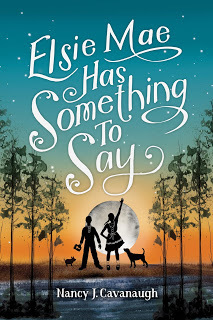
 Now maybe you think I'm being a little too boastful showing off these beauties, but I didn't have anything to do with how fabulous these covers are. The art and design team at Sourcebooks is amazingly smart, talented, and creative; and as far as I'm concerned, they come up with a winner every time. So my "Cover Love" is all about "hats off" to them. They're the ones who make readers want to pick up my books to find out what's inside. And that, after all, is one of the things authors want more than anything in the world.
Now maybe you think I'm being a little too boastful showing off these beauties, but I didn't have anything to do with how fabulous these covers are. The art and design team at Sourcebooks is amazingly smart, talented, and creative; and as far as I'm concerned, they come up with a winner every time. So my "Cover Love" is all about "hats off" to them. They're the ones who make readers want to pick up my books to find out what's inside. And that, after all, is one of the things authors want more than anything in the world.
Happy Reading,Nancy J. Cavanaughwww.NancyJCavanaugh.com@nancyjcavanaugh
I'll start by saying that all my covers are amazing! And not all authors can say that about their books. I know authors who really aren't all that fond of what their book looks like on the outside, so I'm super thankful that I can truly say I love the way my books look on the shelf. But who can blame me. Take a look:





 Now maybe you think I'm being a little too boastful showing off these beauties, but I didn't have anything to do with how fabulous these covers are. The art and design team at Sourcebooks is amazingly smart, talented, and creative; and as far as I'm concerned, they come up with a winner every time. So my "Cover Love" is all about "hats off" to them. They're the ones who make readers want to pick up my books to find out what's inside. And that, after all, is one of the things authors want more than anything in the world.
Now maybe you think I'm being a little too boastful showing off these beauties, but I didn't have anything to do with how fabulous these covers are. The art and design team at Sourcebooks is amazingly smart, talented, and creative; and as far as I'm concerned, they come up with a winner every time. So my "Cover Love" is all about "hats off" to them. They're the ones who make readers want to pick up my books to find out what's inside. And that, after all, is one of the things authors want more than anything in the world.Happy Reading,Nancy J. Cavanaughwww.NancyJCavanaugh.com@nancyjcavanaugh
Published on March 20, 2020 04:30
March 19, 2020
Art+Writing, Art or Writing: All the Arts Sustain Us
While writing was always my first love, art was a close second.
As a high school student, I kept those two worlds fairly separate. I enjoyed my English, creative writing and journalism courses, though I also fully immersed myself into fine art, sculpture, drawing and painting classes. It was my art teacher sophomore year who suggested I intertwine the words and the art. Mostly, she wanted me to have enough to do and create and test my limits. I agreed. My teacher (ironically named Mrs. English) bumped me up a level to a senior art class project. There, second graders at the elementary school were writing a short story. We, as the artists, were to take those words and interpret it into a illustrations and a book cover. Together, it would bring words and art to live - in what better way possible - than a book.
I loved the assignment. I worked with a young girl who wrote about a misfit penguin, who, though lost and lonely for awhile, ultimately found a friend on on another iceberg. Intertwining art and writing together brought me an entirely new love. It was a new way to see the words I wrote and translate them to imagery outside of my head. The little girl kept her hardcover first-print book. I still have the photocopy version.
While I never became a children’s book illustrator nor children’s book writer, it has continued to be a medium I pick up when I’m writing. The distraction of pulling out what’s in my head onto the page as watercolor pigments and ink lines, pouring over the page and taking up space, calms my mind and opens it to where I can get back to writing. Art has always been a form of healing for me, one that opens my mind an doors.

I’m fortunate to have worked with many awesome illustrators in my time as a small town author. Artist Tadgh Bentley took my words of my first middle grade novel, The Great Cat Nap, and did such an amazing, beautiful piece of art for the cover. Every time I see that cover - now as a poster on my wall - I stop and stare into that little world I wrote about and pictured, now brought out so stunningly with details and emotion in layers even deeper than I could have drawn.
One last thought on art in these often frightening days as we quarantine and work to regain and maintain health as a nation and as a world: In these darkest of hours, in these days of fear and ever-changing uncertainty - it is art to which we turn to. To the writers and the dreamers and the drawers and the dancers and the producers. We pick our books we want to read, we loan library books through e-readers, we watch TV for shows and movies and plays where the artists are acting and writing and bringing us hope and light. It the artists who remind us, there is always something to hold onto, to look into, to find peace in.
Happy reading!
As a high school student, I kept those two worlds fairly separate. I enjoyed my English, creative writing and journalism courses, though I also fully immersed myself into fine art, sculpture, drawing and painting classes. It was my art teacher sophomore year who suggested I intertwine the words and the art. Mostly, she wanted me to have enough to do and create and test my limits. I agreed. My teacher (ironically named Mrs. English) bumped me up a level to a senior art class project. There, second graders at the elementary school were writing a short story. We, as the artists, were to take those words and interpret it into a illustrations and a book cover. Together, it would bring words and art to live - in what better way possible - than a book.
I loved the assignment. I worked with a young girl who wrote about a misfit penguin, who, though lost and lonely for awhile, ultimately found a friend on on another iceberg. Intertwining art and writing together brought me an entirely new love. It was a new way to see the words I wrote and translate them to imagery outside of my head. The little girl kept her hardcover first-print book. I still have the photocopy version.
While I never became a children’s book illustrator nor children’s book writer, it has continued to be a medium I pick up when I’m writing. The distraction of pulling out what’s in my head onto the page as watercolor pigments and ink lines, pouring over the page and taking up space, calms my mind and opens it to where I can get back to writing. Art has always been a form of healing for me, one that opens my mind an doors.

I’m fortunate to have worked with many awesome illustrators in my time as a small town author. Artist Tadgh Bentley took my words of my first middle grade novel, The Great Cat Nap, and did such an amazing, beautiful piece of art for the cover. Every time I see that cover - now as a poster on my wall - I stop and stare into that little world I wrote about and pictured, now brought out so stunningly with details and emotion in layers even deeper than I could have drawn.
One last thought on art in these often frightening days as we quarantine and work to regain and maintain health as a nation and as a world: In these darkest of hours, in these days of fear and ever-changing uncertainty - it is art to which we turn to. To the writers and the dreamers and the drawers and the dancers and the producers. We pick our books we want to read, we loan library books through e-readers, we watch TV for shows and movies and plays where the artists are acting and writing and bringing us hope and light. It the artists who remind us, there is always something to hold onto, to look into, to find peace in.
Happy reading!
Published on March 19, 2020 06:57
March 16, 2020
Visual Inspiration, by Michele Weber Hurwitz
There was an old abandoned barn near my house that fascinated me. It was on the route of my usual afternoon walks so I passed it often. It had once been part of a farm no doubt, but now it was the only structure remaining amidst an empty, overgrown plot of land full of tall weeds and discarded items. I loved its worn gray siding and the way it stood a bit lopsided, but mostly, I couldn't help but imagine the life that was once was a part of it.
 Outside the door was a mud-stained baseball. A tangled red ribbon. A smashed plastic milk jug. There was a clear and present sign not to trespass on the property so I didn't go close, but I often stopped on the road just to look. And imagine. There's a story here, I would always think. What happened to the people? Where are they now? Did they have to leave quickly for some reason, so fast that a boy forgot his baseball and the ribbon loosened and fell from a girl's ponytail? What did the area look like when it was all farms? Filled with their neighbors. Their friends.
Outside the door was a mud-stained baseball. A tangled red ribbon. A smashed plastic milk jug. There was a clear and present sign not to trespass on the property so I didn't go close, but I often stopped on the road just to look. And imagine. There's a story here, I would always think. What happened to the people? Where are they now? Did they have to leave quickly for some reason, so fast that a boy forgot his baseball and the ribbon loosened and fell from a girl's ponytail? What did the area look like when it was all farms? Filled with their neighbors. Their friends.
Soon after I discovered the barn and took this picture, it was torn down, and in its place -- what else -- brand new row houses were being built. I cried a little at the sight of bulldozers and torn-up earth. The baseball and ribbon were gone.
Like many writers, I think visually. When I see something like the barn and it sticks in my mind so strongly, it helps me create settings and scenes. For my new middle grade novel releasing in May, Hello from Renn Lake, I had such a vivid visual scene for the opening chapter. One moonless night, a baby girl is abandoned near the back garden of a store in a small Wisconsin town, and the ancient lake across the street is the only witness. I could see the garden, its flowers and long grasses bending in the slow summer breeze. I saw the lake, as still and dark as the black sky. I saw a figure holding a baby wrapped in a blanket, one tiny hand poking out.
Sometimes, I'm so immersed in the visual world I'm creating while I write, I feel like it's a real place and I'm there. I have literally jumped when the doorbell rings (just FedX delivering a package, because who else would it be in this day and age). Everywhere, there are sights to be found that can help writers visualize and create. Be on the lookout! And when you see something that sparks your soul, stop and imagine.
Michele Weber Hurwitz is the author of five middle grade novels, from Penguin Random House and Simon & Schuster. Find her online at micheleweberhurwitz.com
 Outside the door was a mud-stained baseball. A tangled red ribbon. A smashed plastic milk jug. There was a clear and present sign not to trespass on the property so I didn't go close, but I often stopped on the road just to look. And imagine. There's a story here, I would always think. What happened to the people? Where are they now? Did they have to leave quickly for some reason, so fast that a boy forgot his baseball and the ribbon loosened and fell from a girl's ponytail? What did the area look like when it was all farms? Filled with their neighbors. Their friends.
Outside the door was a mud-stained baseball. A tangled red ribbon. A smashed plastic milk jug. There was a clear and present sign not to trespass on the property so I didn't go close, but I often stopped on the road just to look. And imagine. There's a story here, I would always think. What happened to the people? Where are they now? Did they have to leave quickly for some reason, so fast that a boy forgot his baseball and the ribbon loosened and fell from a girl's ponytail? What did the area look like when it was all farms? Filled with their neighbors. Their friends.Soon after I discovered the barn and took this picture, it was torn down, and in its place -- what else -- brand new row houses were being built. I cried a little at the sight of bulldozers and torn-up earth. The baseball and ribbon were gone.
Like many writers, I think visually. When I see something like the barn and it sticks in my mind so strongly, it helps me create settings and scenes. For my new middle grade novel releasing in May, Hello from Renn Lake, I had such a vivid visual scene for the opening chapter. One moonless night, a baby girl is abandoned near the back garden of a store in a small Wisconsin town, and the ancient lake across the street is the only witness. I could see the garden, its flowers and long grasses bending in the slow summer breeze. I saw the lake, as still and dark as the black sky. I saw a figure holding a baby wrapped in a blanket, one tiny hand poking out.
Sometimes, I'm so immersed in the visual world I'm creating while I write, I feel like it's a real place and I'm there. I have literally jumped when the doorbell rings (just FedX delivering a package, because who else would it be in this day and age). Everywhere, there are sights to be found that can help writers visualize and create. Be on the lookout! And when you see something that sparks your soul, stop and imagine.
Michele Weber Hurwitz is the author of five middle grade novels, from Penguin Random House and Simon & Schuster. Find her online at micheleweberhurwitz.com
Published on March 16, 2020 05:30
March 15, 2020
Rise UP
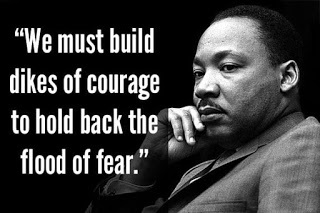 Talking a slight detour from this month’s focus on art, I thought I’d share some words on the frenetic activities swirling around my life, and have no doubt touched all of our lives in some way. I admit, it’s hard to focus on making art during these mad times of pandemics, economic recessions, elections, emergencies, layoffs.
Talking a slight detour from this month’s focus on art, I thought I’d share some words on the frenetic activities swirling around my life, and have no doubt touched all of our lives in some way. I admit, it’s hard to focus on making art during these mad times of pandemics, economic recessions, elections, emergencies, layoffs.But I find comfort in these words, by Martin Luther King, Jr.
“Courage is that quality which enables us to stand up to any fear. It is the final determination not to be stopped or overwhelmed by any object, however frightful it may be. Many of our fears are very real, and not mere snakes under the carpet. Trouble is a reality in this strange medley of life and dangers lurk beneath our every move….Courage is the inner determination to go on in spite of obstacles and frightening situations; cowardice is the submissive surrender to the forces of circumstance. The man of courage never loses the zest for living even though his life situation is zestless; the cowardly man, overwhelmed by the uncertainties of life, loses the will to live. Courage breeds creative self‐affirmation; cowardice breeds destructive self-abnegation. Courage faces fear and thereby masters it; cowardice represses fear and is thereby mastered by it. So we must constantly build dykes of courage to ward off the flood of fear.”
Music helps, too.
You're broken down and tiredOf living life on a merry-go-round
And you can't find the fighter
But I see it in you so we gonna walk it out
And move mountains
And I'll rise up
I'll rise like the day
I'll rise up
I'll rise unafraid
I'll rise up
And I'll do it a thousand times again
And I'll rise up
--Andra Day. Rise Up (Warner Bros. Records, Aug. 28, 2015)
And, when all else fails, there’s a bit of scary humor. Because pandemics and zombies go together like Michael Jackson and Thriller.
What are your favorite words of courage? Your favorite songs of inspiration?
For Martin Luther King’s full sermon on overcoming fear, see "The Mastery of Fear or Antidotes for Fear". MLKP, MBU, Martin Luther King, Jr., Papers, 1954-1968, Howard Gotlieb Archival Research Center, Boston University, Boston, Mass.
--Bobbi Miller
Published on March 15, 2020 05:09
March 12, 2020
Book Cover Art...Do Author's Get to Choose?
In answer to the question posed in the title, in most instances, authors who are not illustrators have little say in what ends up on the cover of their books. It can be frustrating when the choice isn't what we hoped for, or something to celebrate when it is much more than we imagined.
For my latest book WISHES, DARES, AND HOW TO STAND UP TO A BULLY (Creston April 2020), I had the unique opportunity to weigh in on the images that appeared on the front and back covers of the book. My editor/publisher asked me what I thought should be included.
Set up as a NOTEBOOK written by an eleven-year-old boy, the images reflect the summer of adventure and discovery he shared with his family and new friends.
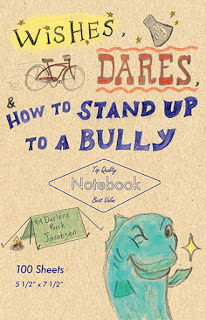 The story takes place in the summer of 1964, so the rocket represents the new Mercury space program. The main character Jack, discovers his Dad's old Schwinn bike and rides it all summer. Jack, sister Katy, and a new friend named Jill camp out in the backyard tent on many nights. The one-eyed fish - named FRED - grants wishes that change the lives of everyone that summer.
The story takes place in the summer of 1964, so the rocket represents the new Mercury space program. The main character Jack, discovers his Dad's old Schwinn bike and rides it all summer. Jack, sister Katy, and a new friend named Jill camp out in the backyard tent on many nights. The one-eyed fish - named FRED - grants wishes that change the lives of everyone that summer.

On the back cover, Katy draws a face on a beach ball Gran gives her and names the ball Bouncy. Bouncy becomes a character of sorts in the story. The key opens a box Jack discovers in the dusty attic. A box that holds his Dad's notebook that was written when he was a boy Jack's age. And, what would a summer be without milkshakes and ice-cream sodas?
It was a joy and honor to have made the suggestions for the images that appear on the final cover. A cover that tells a story of it's own.
For my latest book WISHES, DARES, AND HOW TO STAND UP TO A BULLY (Creston April 2020), I had the unique opportunity to weigh in on the images that appeared on the front and back covers of the book. My editor/publisher asked me what I thought should be included.
Set up as a NOTEBOOK written by an eleven-year-old boy, the images reflect the summer of adventure and discovery he shared with his family and new friends.
 The story takes place in the summer of 1964, so the rocket represents the new Mercury space program. The main character Jack, discovers his Dad's old Schwinn bike and rides it all summer. Jack, sister Katy, and a new friend named Jill camp out in the backyard tent on many nights. The one-eyed fish - named FRED - grants wishes that change the lives of everyone that summer.
The story takes place in the summer of 1964, so the rocket represents the new Mercury space program. The main character Jack, discovers his Dad's old Schwinn bike and rides it all summer. Jack, sister Katy, and a new friend named Jill camp out in the backyard tent on many nights. The one-eyed fish - named FRED - grants wishes that change the lives of everyone that summer.
On the back cover, Katy draws a face on a beach ball Gran gives her and names the ball Bouncy. Bouncy becomes a character of sorts in the story. The key opens a box Jack discovers in the dusty attic. A box that holds his Dad's notebook that was written when he was a boy Jack's age. And, what would a summer be without milkshakes and ice-cream sodas?
It was a joy and honor to have made the suggestions for the images that appear on the final cover. A cover that tells a story of it's own.
Published on March 12, 2020 06:00
March 11, 2020
Art = Art by Jody Feldman
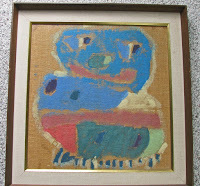 Bug by Jody Feldman, age 6I knew, from a very early age, that when I grew up, I’d never become an artist. Don’t misunderstand. I loved to draw and paint and create. And the things I drew were completely recognizable.
Bug by Jody Feldman, age 6I knew, from a very early age, that when I grew up, I’d never become an artist. Don’t misunderstand. I loved to draw and paint and create. And the things I drew were completely recognizable. It’s just that the man whose bedroom was around the corner from mine WAS an artist...by profession. I’d stand right next to his drawing table, mesmerized, as my dad made things appear from nothing but a blank piece of paper and a pencil or marker or paintbrush or airbrush.
It’s just that the man whose bedroom was around the corner from mine WAS an artist...by profession. I’d stand right next to his drawing table, mesmerized, as my dad made things appear from nothing but a blank piece of paper and a pencil or marker or paintbrush or airbrush.I knew I could never be that good. What I didn’t know, and what I try to tell kids when I visit schools, is that he didn’t draw like that when he was my age. It took him years of school and work; years of developing and honing; years of trials and mistrials and, especially, dedication before he climbed to the top tier of his profession.
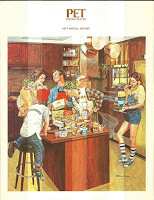
It’s funny. From my current perspective, I can see the parallels; how we, as writers, also make magic appear from a blank piece of paper. How we weren’t born with this ability. How we’ve needed to find the dedication to work and develop and hone. How we go through mistakes and mistrials to produce a collection of words that are worthy of others to read.
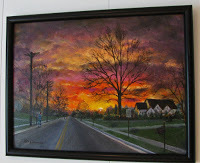 Even at the close of his career, my dad still played with new techniques and media while he worked on his craft. As for me? I hope; no, I expect these parallels to continue.
Even at the close of his career, my dad still played with new techniques and media while he worked on his craft. As for me? I hope; no, I expect these parallels to continue.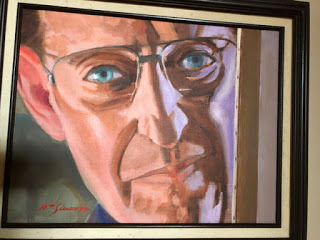 Self-portrait of the artist
Self-portrait of the artist
Published on March 11, 2020 04:00
March 8, 2020
Doodles To The Rescue -- by Jane Kelley
When I started my first MG novel,
Nature Girl
, I was just as naive as my character. Megan thought it would be easy to hike twenty miles on the Appalachian Trail--even though she had hardly any food or water, no camping gear, and no real knowledge of how to survive in the wilderness. That pretty much described me too (although I did have food and water). I also had some excellent advice. My husband and daughter were early readers. My agent Linda Pratt understood my novel and was very wise about the publishing world. Before Linda matched me with my excellent editor Shana Corey, I got a great suggestion from another editor.
Your character is alone through most of the book. Can you give her something to do?
Alone? Of course she's alone! That's the point! Megan discovers her inner strength by reaching her goal on her own. But her solitary journey was also a problem. When she was alone, with just her thoughts and that yucky voice, she became one note.
Maybe Megan can doodle?
In early versions, Megan only doodled during "Art Time." Doodling was just something else she didn't like about herself. It never occurred to me to let her continue to draw her adventures. Those additional doodles helped the book in so many ways.
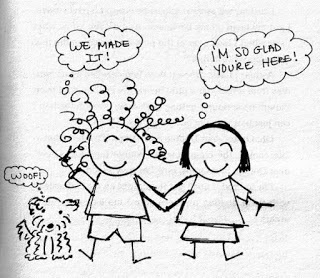 Art by Heather PalisiMegan's sketches became a dialogue with herself. In this one, she is imagining the happy ending to her story. This is pretty important because the reader needs to know that Megan isn't lost or running away. Megan has a positive reason for what she's doing. Oh--and Megan needs to know that too!
Art by Heather PalisiMegan's sketches became a dialogue with herself. In this one, she is imagining the happy ending to her story. This is pretty important because the reader needs to know that Megan isn't lost or running away. Megan has a positive reason for what she's doing. Oh--and Megan needs to know that too!
Megan was wrong about her doodles. They weren't just trash, as she thought. Art isn't only something that hangs on a museum wall. Art is anything that encourages us to look at our world in a new way.
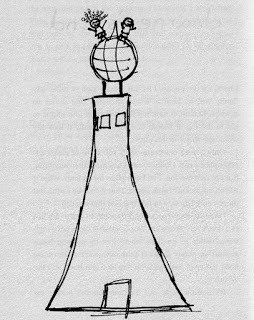
By the end of Megan's journey, she has accomplished her goal. She has arrived at Mount Greylock. She is a stronger, better person. In reality, she can't stand up on top of the monument and she won't meet her friend for a few more pages. But this picture shows us how she feels--on top of the world.
In fiction we always strive to show not tell. Even if you don't have an amazing illustrator like Heather Palisi, you can incorporate visual thinking in your story. Art will add dimension and perspective. Art takes us outside of ourselves. Maybe most importantly, art is fun.

There are many great books in which characters make art. One of my favorites is Meena Meets Her Match by Karla Manternach. The sequel, Never Fear, Meena's Here, will be out later this month. I'm eager to read how Meena continues to turn trash into treasure to transform her world.
Your character is alone through most of the book. Can you give her something to do?
Alone? Of course she's alone! That's the point! Megan discovers her inner strength by reaching her goal on her own. But her solitary journey was also a problem. When she was alone, with just her thoughts and that yucky voice, she became one note.
Maybe Megan can doodle?
In early versions, Megan only doodled during "Art Time." Doodling was just something else she didn't like about herself. It never occurred to me to let her continue to draw her adventures. Those additional doodles helped the book in so many ways.
 Art by Heather PalisiMegan's sketches became a dialogue with herself. In this one, she is imagining the happy ending to her story. This is pretty important because the reader needs to know that Megan isn't lost or running away. Megan has a positive reason for what she's doing. Oh--and Megan needs to know that too!
Art by Heather PalisiMegan's sketches became a dialogue with herself. In this one, she is imagining the happy ending to her story. This is pretty important because the reader needs to know that Megan isn't lost or running away. Megan has a positive reason for what she's doing. Oh--and Megan needs to know that too!Megan was wrong about her doodles. They weren't just trash, as she thought. Art isn't only something that hangs on a museum wall. Art is anything that encourages us to look at our world in a new way.

By the end of Megan's journey, she has accomplished her goal. She has arrived at Mount Greylock. She is a stronger, better person. In reality, she can't stand up on top of the monument and she won't meet her friend for a few more pages. But this picture shows us how she feels--on top of the world.
In fiction we always strive to show not tell. Even if you don't have an amazing illustrator like Heather Palisi, you can incorporate visual thinking in your story. Art will add dimension and perspective. Art takes us outside of ourselves. Maybe most importantly, art is fun.

There are many great books in which characters make art. One of my favorites is Meena Meets Her Match by Karla Manternach. The sequel, Never Fear, Meena's Here, will be out later this month. I'm eager to read how Meena continues to turn trash into treasure to transform her world.
Published on March 08, 2020 06:00



